Engineering Encounters
Authors and Engineers
Applying engineering principles to create pop-up books
Although incorporating engineering into science instruction seems straightforward, adding more content into an already busy school day may be overwhelming for some teachers. To address this challenge, we created a unit that integrates engineering and literacy instruction. This article demonstrates how young students can learn sophisticated engineering principles within the context of fun and engaging lessons.
During our combined engineering and literacy unit (modified from Benenson 2014), third graders created pop-up books over the course of 10 days (see unit overview and materials). To maintain a focus on engineering principles, we chose to focus on two simple pop-up folds: parallel and angle folds. Students wrote their pop-up books on figures of speech, a focus of their literacy class at the time. Students used a graphic organizer to plan their writing before transferring it into their pop-up books. Students also used writing throughout the unit to support their learning of engineering principles.
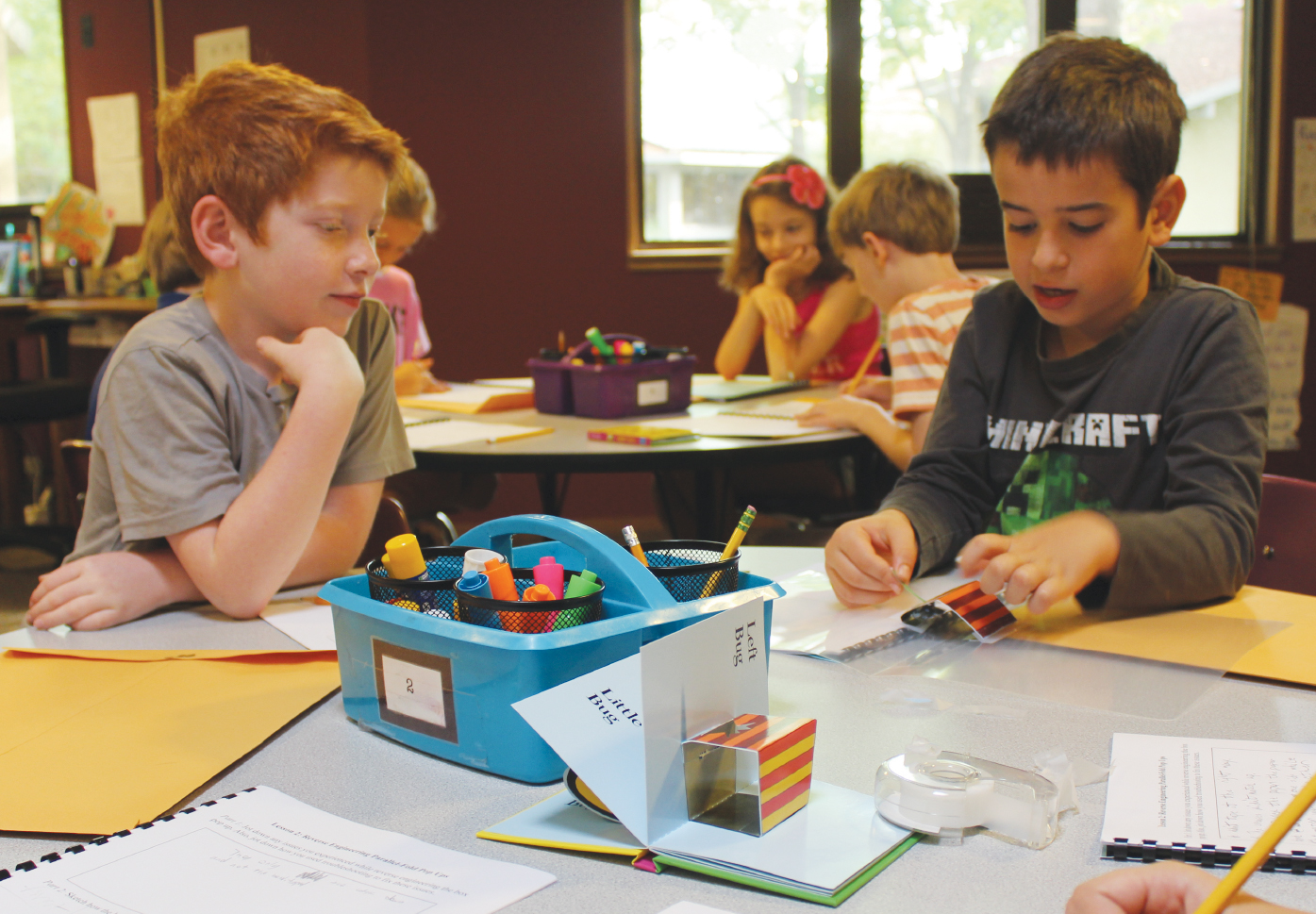
Writing Like an Engineer
During each lesson, students engaged in writing activities to practice the specialized ways that engineers develop and express their ideas in writing (NRC 2012). Students completed all writing activities in a sketchbook, a spiral-bound notebook, which consisted of two to three writing pages and writing prompts per lesson.
Students took notes about the motion of commercial pop-up books, and in later lessons, sketched how pop-ups move when a pop-up book opens and closes. These activities not only addressed writing but also had students observe and record the motion of different pop-ups. Additionally, students described how to troubleshoot issues and solve design challenges. For example, one of the prompts read: Jot down any issues you experienced while reverse engineering the pop-up. Also, jot down how you used troubleshooting to fix these issues. Other writing prompts asked students to record how they built and tested their pop-up prototypes. We encouraged students to sketch and draw, jot down notes and ideas, and write complete sentences, depending on the lesson and the student. Because we wanted to focus on the writing process as a means for personal expression and knowledge creation, we never gave feedback or grades on students’ writing. We allowed students to write together with their peers in small groups. Thus, all students, regardless of their writing skills, could use the sketchbook in the way that worked best for them.
Students referred to these initial sketchbook activities as they learned new concepts and designed their own pop-up books. Each lesson began with a class discussion of what students had written in their sketchbooks during the previous lesson; this allowed us to activate background knowledge at the start of each lesson.
Learning about Pop-Ups
To begin the unit, students examined a variety of commercial pop-up books that included simple and complex pop-ups. This activity activated students’ prior knowledge and excited them about making their own pop-up books. While examining these books, students recorded in their sketchbooks what they noticed about how pop-ups work. Students noted that for a pop-up to work, it must be attached to both sides of the book and that some pop-ups moved in different directions (e.g., horizontally or vertically) when opening the book. During a class discussion, we taught students common vocabulary for the parts of a pop-up book. For example, students began using gutter to describe the crease down the center of the book and page positions to describe the attachment points of the pop-up on the left and right side of the page. Students labeled parts of a pop-up book in their sketchbooks using these terms.
Lessons in Reverse Engineering
In the next lesson, students reverse engineered a parallel-fold pop-up from the book Opposites (Carter 2010). Reverse engineering, used by engineers to design and redesign products, is also a beneficial strategy young students can employ to engage in engineering practices (McGowan, Ventura, and Bell 2017). To reverse engineer, students removed a pop-up from Opposites and attached it into a transparent book. This activity was particularly exciting for students, as they had the opportunity to tear apart a book, something that is usually taboo in a school setting. In a transparent book, which consists of two overhead transparencies taped together, students can observe the attachment and motion of pop-ups obscured by a book’s opaque pages and cover. To make the reverse-engineered pop-up function exactly as it did in the commercial book, students attached it into the transparent book at specific page positions. If students attached the pop-up too close or too far from the gutter, the pop-up became mangled after closing the book. As a result, students tried a variety of solutions to make their reverse-engineered pop-ups work correctly. They used more (or less) tape to attach the pop-up to the transparent book. They also experimented with attaching the pop-up at different page positions inside the transparent book. We then introduced to students the term troubleshooting, the process of testing different solutions to solve design problems to describe the process they had just experienced.
Students then completed a similar reverse-engineering activity where they reverse engineered an angle-fold pop-up from The Wide-Mouthed Frog (Faulkner 1996). Then, students compared how the pop-ups in each reverse-engineering lesson moved. This comparison helped students recognize that parallel-fold pop-ups move left to right and angle-fold pop-ups move up and down.
Exploring Structure and Function
After each reverse-engineering lesson, students participated in design challenges. Each series of design challenges helped students learn how parallel- and angle-fold pop-ups function. To do this effectively, students used their transparent books to observe attributes of pop-up height, motion, and location (e.g., the location of page positions and whether the pop-up was on the left or right side of the book). All design challenges followed the same three steps:
- troubleshoot to find solutions;
- observe the motion of the designed pop-up solution; and
- report on the process and solution in sketchbooks, discussions with peers, and class discussions at the end of each challenge.
To meet the needs of a variety of learners, we had students work in small groups (3–5 students) to solve design challenges and provided both written and verbal opportunities for students to explain and reflect on their learning. In the first series of design challenges (with parallel-fold pop-ups), students groups created a pop-up by attaching a long strip of paper into their transparent books. Students had to make sure the pop-up did not protrude from the book when closed. Through troubleshooting, students found that the pop-up remained in the book when attached at page positions close to the gutter (Figure 1, p. 59).
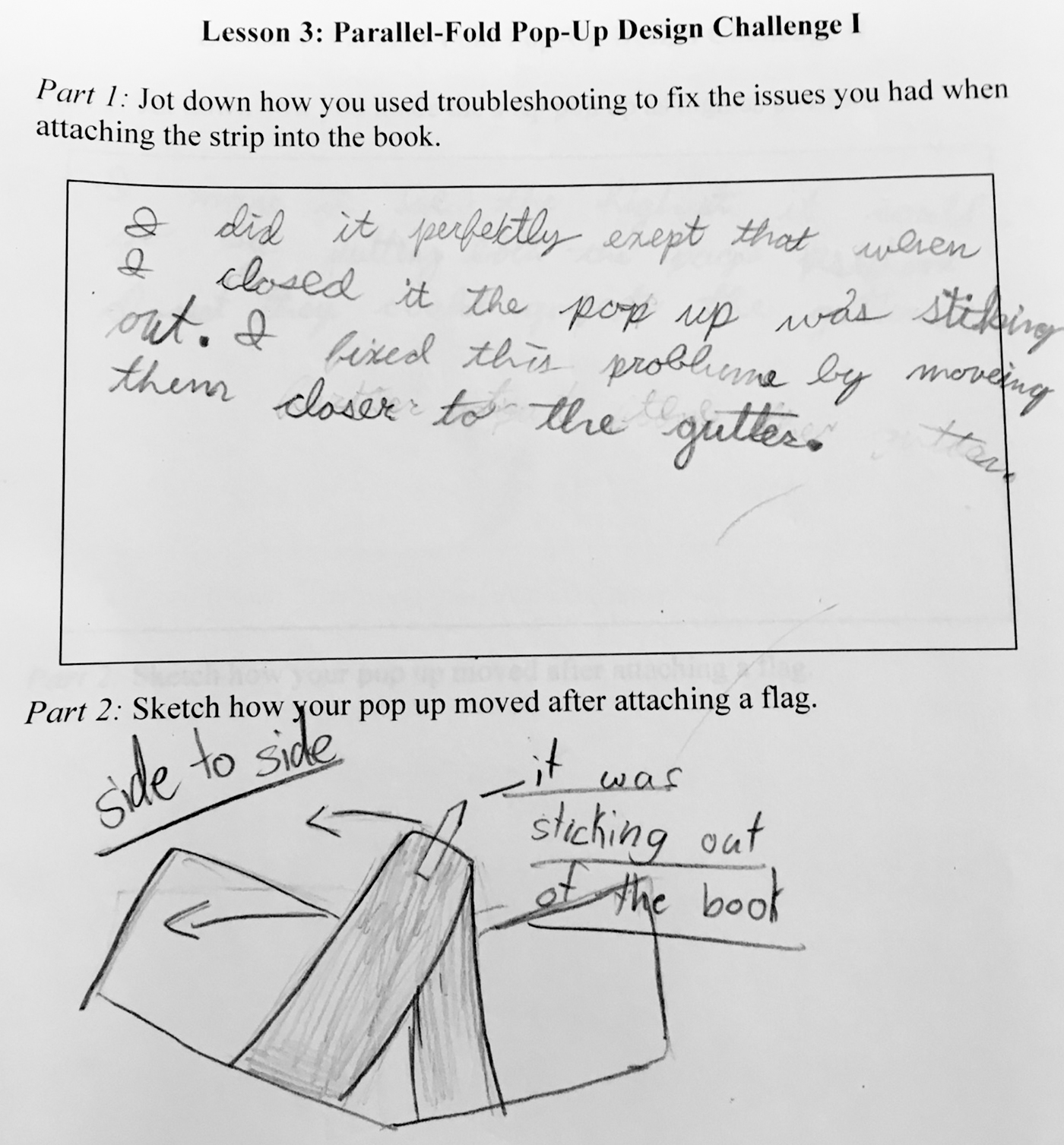
In the next lesson, students completed challenges using a shorter strip of paper to make parallel-fold pop-ups that: pop up to a maximum height without protruding from the book, do not pop up at all, pop up in the center of the book, and pop up on the right side of the book (Figure 2). During this time, students learned that there are tradeoffs of height for motion—that is, a pop-up that pops high off of the page will have less motion than a pop-up that pops low off of the page. We discussed the term tradeoffs and encouraged students to use it in their talk and writing during design challenges.
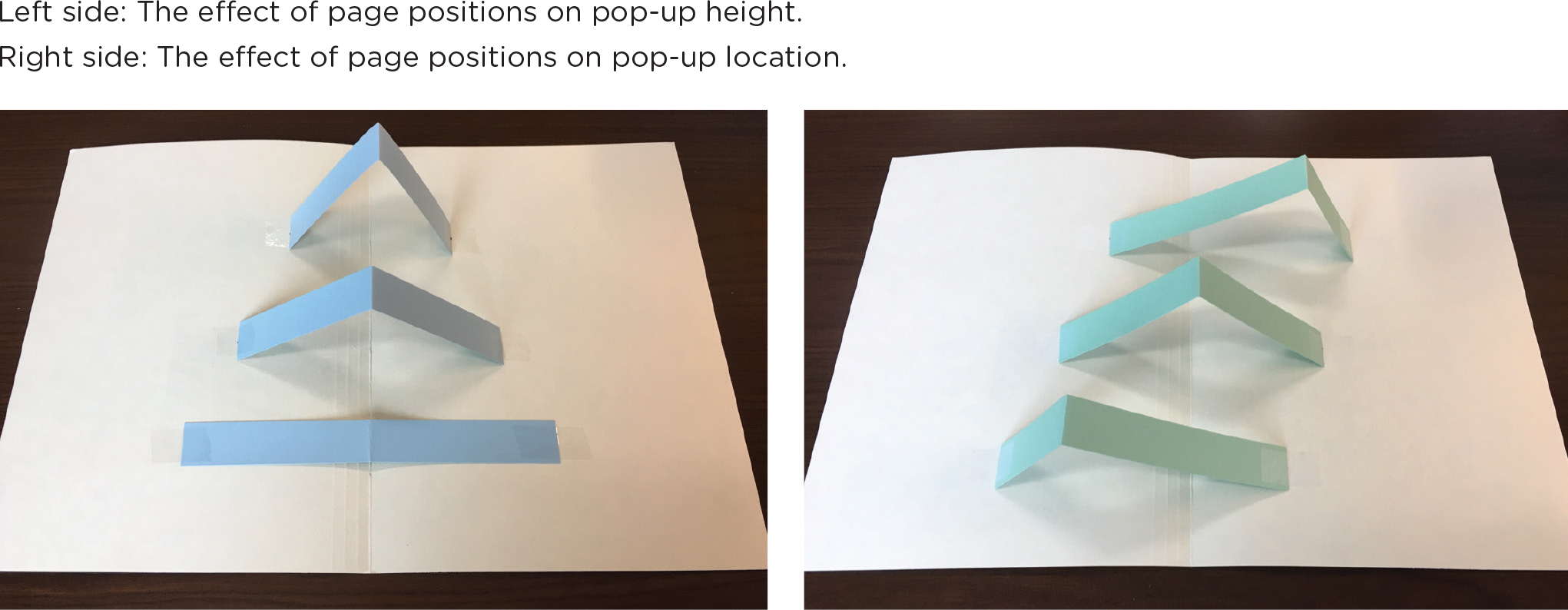
Students followed similar steps in the second series of design challenges with angle-fold pop-ups. In this lesson, students completed angle-fold pop-ups that pop up to a maximum height and pop up on the left or right side of the book.
Building and Optimizing Prototypes
At the end of each series of design challenges, students built a prototype pop-up for their book. The student-created parallel- and angle-fold pop-ups served as models for students to use in their own books. Prototypes are early models engineers use to help refine their ideas, explore design alternatives, and troubleshoot unanticipated design issues (Brophy et al. 2008).
Before students built their prototype pop-ups, we asked them if they had heard the term prototype or if they knew how engineers used prototypes. Students learned that prototypes are more like rough drafts than final drafts. We emphasized that building a prototype would help students optimize their pop-up. We discussed how an optimized pop-up was more like a final draft, as it was the best possible solution given a student’s goals and constraints.
To create their prototype pop-ups, students cut shapes and figures from card stock and attached the card stock cutouts into manila folders using scotch tape. Students also opened and closed their folders to see how pop-ups would function inside their final books and troubleshot any possible problems. When building their prototypes, we reminded students to consider tradeoffs (e.g., giving up height to get more motion). Some students tried to make their prototype work perfectly or over-decorate their prototype. To avoid this, we reminded students that their prototypes were not meant to be final products.
Pop-Up Showcase
During the final two lessons, students finished their pop-up books. Because students were at various stages of pop-up book completion, we adapted our instruction to students’ needs and provided individual assistance to make sure each student finished his or her book. For example, some students needed help deciding where to place pop-ups on each page of their book, while others needed assistance with prototyping additional pages for their book. Others who were nearly done asked for help completing final touches and aesthetic components of their pages.
We invited teachers, parents, family members, and friends to a pop-up party on the final day of the unit. During the celebration, students showcased their work (Figure 3), read sections of their books aloud, and explained the process of designing, building, and authoring their pop-up books.
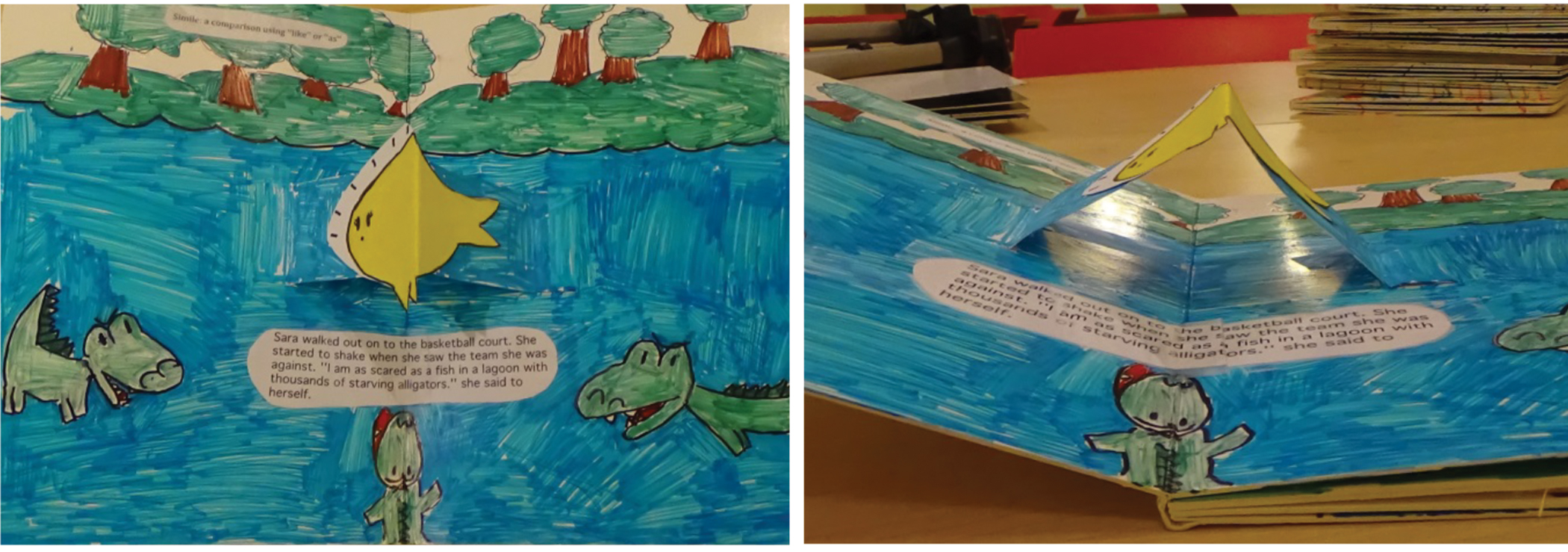
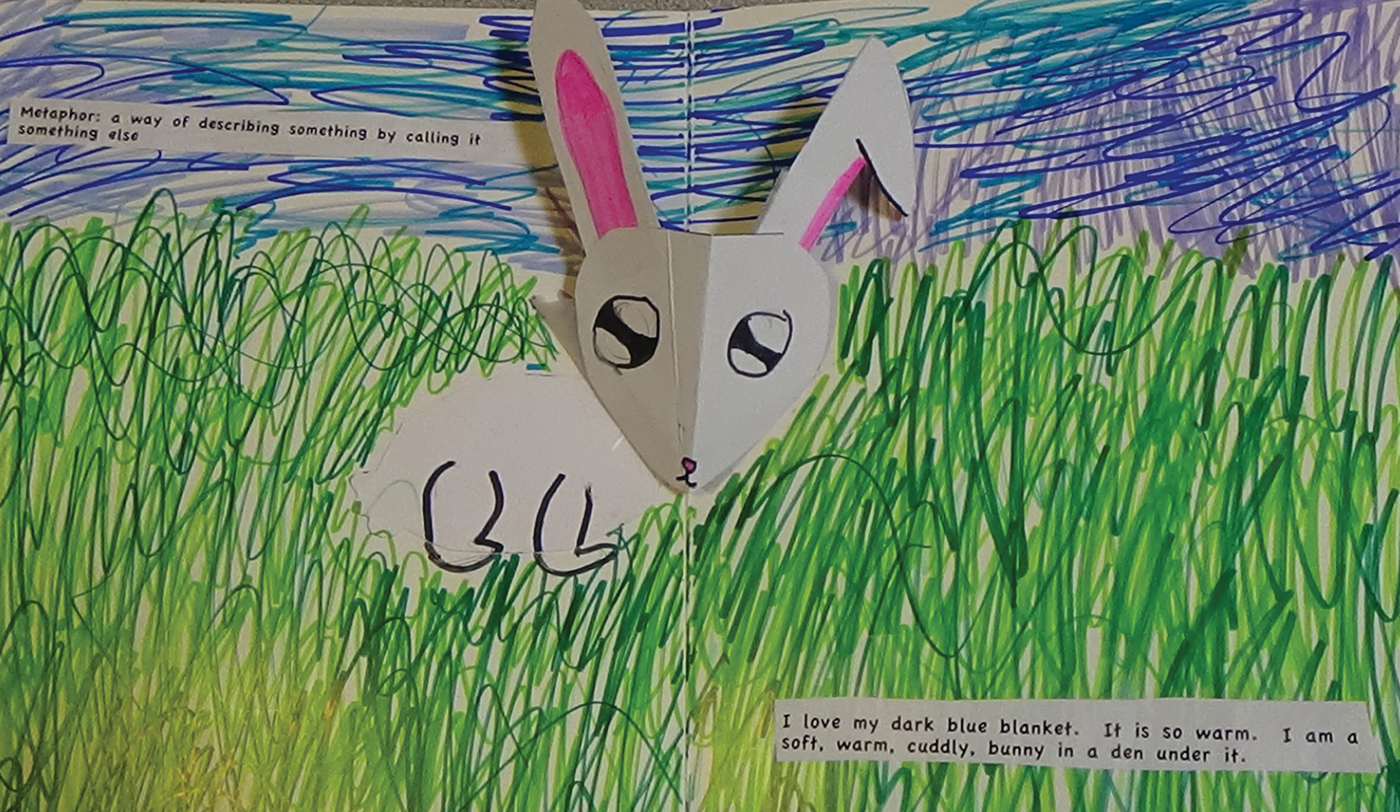
Conclusion
Integrating engineering and literacy around creating and authoring pop-up books is educational and engaging. After participating in the unit, our students were able to express their new knowledge of engineering principles both verbally and in writing. We used three different assessments to judge what students learned. First, students completed a vocabulary assessment in which they matched engineering and pop-up terms to their definitions. Second, students completed a written essay response. In this response, we asked them to describe the process of building pop-ups for a college-age student who had never experienced building a pop-up. Third, students completed an oral interview. In this oral interview, students examined five pairs of commercial pop-up books and identified unique features of each pair.
Students demonstrated significant growth on all assessments from pre- to posttest. Thus, after participating in the unit, students were able to demonstrate their new knowledge of grade-level engineering design standards in multiple ways: (a) recall on vocabulary assessments, (b) written language representation on essay responses, and (c) oral language representation in interviews. From this, we believe that by engaging in engineering practices (e.g., reverse engineering, troubleshooting, prototyping, and optimizing) related to grade-level standards, students developed a deep understanding of how to apply engineering principles to solve real-world problems. Further, informal observations and a student survey showed students enjoyed the unit and found what they learned useful. As one student exclaimed, “I learned a lot while having so much fun!”


